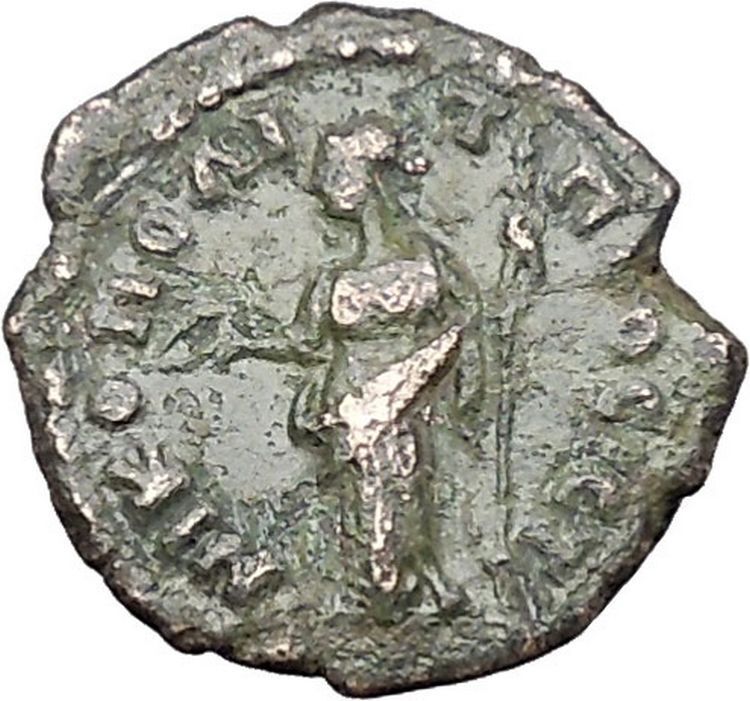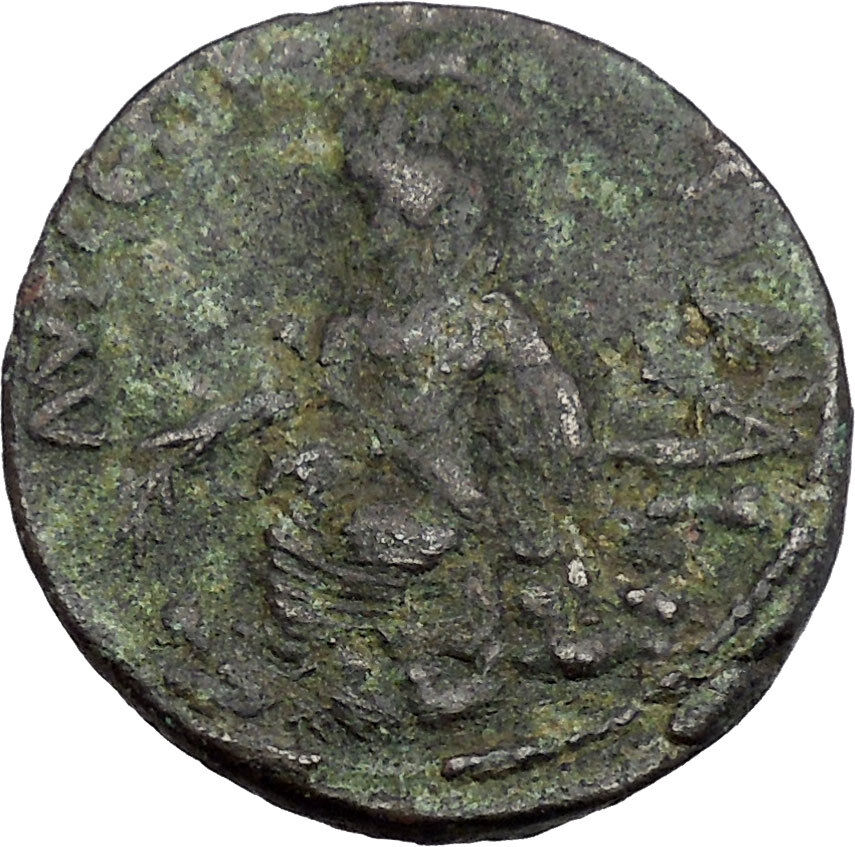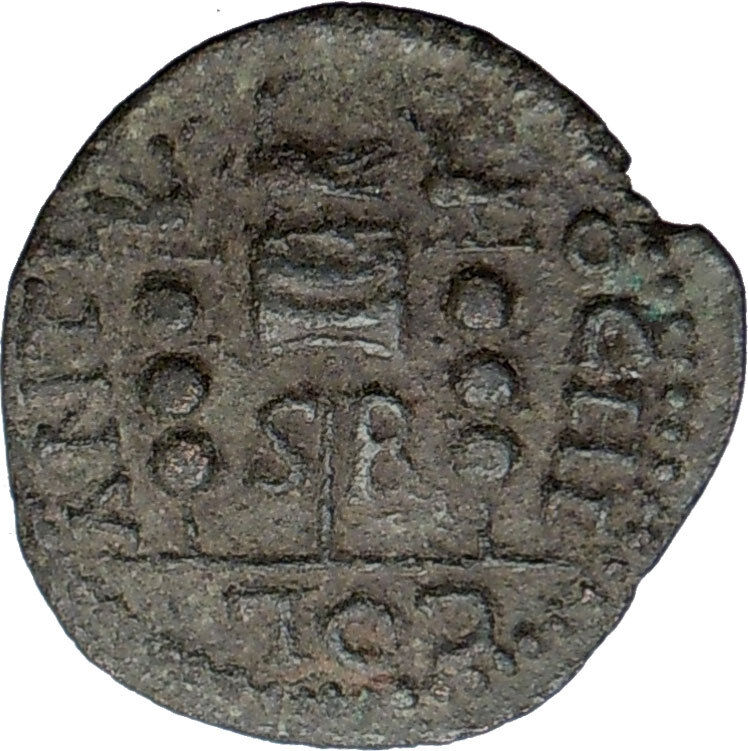|
Greek city of Aezanis in Phrygia
Bronze 17mm (4.10 grams) Struck during the time of Roman Emperor Claudius 41-54 A.D.
Reference: Sear GIC 5058; RPC I 3106; BMC Phrygia pg. 23, 5
ΘЄΟC CVNKΛHΤOC, Young diademed and draped bust of the Roman Senate right.
AIZANITΩN, Draped bust of Artemis right, quiver at shoulder.
You are bidding on the exact item pictured, provided with a Certificate of Authenticity and Lifetime Guarantee of Authenticity.
Roman Senate
One of the most personifications represented emissions autonomous provincial Roman is that of the Roman Senate , widely present emissions of Lydia and Phrygia , in general, much of Asia Minor (Table 9a- c ) .
The reason may be found in the fact that the province of Asia was under the control of the Senate, but this conclusion clashes with the evidence that the Senate has never shown instead in the emissions of other provinces Senators, such as Bithynia .
Emissions autonomous province with the Senate of Rome covering virtually the whole of the period from Tiberius to Philip I, with a maximum in the period of the Antonines and the Severi .
Coinage in the iconography of imperial Rome , the Senate appears robed , with a beard as a sign of maturity , the scepter as a sign of power and sometimes with an olive branch . It is often portrayed in the presence of the imperial figure , ie the emperor shaking hands as a sign of harmony or only hope for such a harmony between the parties, as it appears on a sestertius of Commodus RIC III 549 , a similar scene is found on a sestertius of Hadrian RIC II 968, but here also appears the figure of Rome holding her hands on those imperial and Senate that huddle . On a golden age of Trajan takes on a quasi-religious while sacrificing on an altar in front of the Genius of the Roman People (RIC 374). E ‘ instead of a lone Caracalla Antoninianus RIC 246 and a golden Commodus RIC 157a . The inscription Genivs SENATVS confirms that the embodiment in question is precisely that of the Roman Senate .
In contrast to what was seen for the imperial emissions , the Senate of Rome autonomous provincial emissions is depicted with a portrait male youth with medium length hair type Genio Populi Romani or Bonus Eventus , sometimes the picture is instead purely feminine and l ‘ hairstyle becomes similar to that of Plotina , wife of Trajan, or that of Longina Domitia , wife of Domitian as it appears on the issues of mint Apollonis in Lydia (fig. 14).
The legends that accompany the portrait in emissions are almost independent of the provincial type CYNKΛHTOC, ΣYNKΛHTOC, IERA CYNKΛHTOC, ΘEON CYNKΛHTON, ΣYNKΛHTON or ΘEON CYNKΛHTOY and leave no doubt on the identification. The appeal is therefore the authority of Rome through his organ very representative, who takes on a sacred (IEPA) or divine (ΘEON). As mentioned above, the period Flavio brand the passage from the use of ΘEOΣ to IEPA.
A large bronze issued to Mallus in Cilicia (BMC 30, Levante 1286) portrays the personification with head veiled in conjunction enrollment SACRED SINATVS (fig. 15). In this case, even though the Senate is in the masculine gender, the personification is typically feminine boulh in greek is in fact female and perhaps the engraver of this type did not know Latin well (considering also the obvious corruption of SENATVS in SINATVS) and has remade the genre greek. A similar issue shows instead the legend SACER SENATVS (Ovens n. 537).
How to interpret the presence of this representation emission Greek imperial is not easy. It is probably limited to believe that confirmation of the subjection of the Greek cities in Rome were confirmed by the presence of a call to the Senate, since over time the importance of the same was gradually decreasing, while his cult in the provinces remained almost unchanged. It should not be forgotten that the Roman Senate assumes emissions pseudo autonomous on a religious or divine, or IEPA ΘEON (the Senate is the only cult that was called both divine and sacred), and this probably has nothing to do with the control politician of the provinces. “The deification and the consecration of the Roman Senate are a product of the school of thought of the Eastern world, who wants to be surrounded by a halo and be the object of worship every manifestation of human power, as this is considered emanation of divine power” (Forni, 1954).
Artemis was one of the most widely venerated of the Ancient Greek deities. Some scholars believe that the name, and indeed the goddess herself, was originally pre-Greek. Homer refers to her as Artemis Agrotera, Potnia Theron < Artemis of the wildland, Mistress of Animals”. In the classical period of Greek mythology, Artemis (Greek: (nominative) Ἄρτεμις, (genitive) Ἀρτέμιδος) was often described as the daughter of Zeus and Leto, and the twin sister of Apollo. She was the Hellenic goddess of the hunt, wild animals, wilderness, childbirth, virginity and young girls, bringing and relieving disease in women; she often was depicted as a huntress carrying a bow and arrows. The deer and the cypress were sacred to her. In later Hellenistic times, she even assumed the ancient role of Eileithyia in aiding childbirth. described as the daughter of Zeus and Leto, and the twin sister of Apollo. She was the Hellenic goddess of the hunt, wild animals, wilderness, childbirth, virginity and young girls, bringing and relieving disease in women; she often was depicted as a huntress carrying a bow and arrows. The deer and the cypress were sacred to her. In later Hellenistic times, she even assumed the ancient role of Eileithyia in aiding childbirth.
Artemis later became identified with Selene, a Titaness who was a Greek moon goddess, sometimes depicted with a crescent moon above her head. She was also identified with the Roman goddess Diana, with the Etruscan goddess Artume, and with the Greek or Carian goddess Hecate.
Aizanoi was an ancient city in western Anatolia. Located in what is now Çavdarhisar, Kütahya Province, Aizanoi is situated astride the River Penkalas, some 1,000 m (3,300 ft) above sea level. The city was an important political and economic centre in Roman times; surviving remains from the period include a well-preserved Temple of Zeus, unusual combined theatre-stadium complex, and macellum inscribed with the Price Edict of Diocletian. The city fell into decline in Late Antiquity. Later serving as a citadel, in 2012 the site was submitted for inscription on the UNESCO World Heritage List.
History
Settlement in the area is known from the Bronze Age. The city may have derived its name from Azan, one of three sons of Arcas and the nymph Erato, legendary ancestors of the Phrygians. During the Hellenistic period the city changed hands between the Kingdom of Pergamum and the Kingdom of Bithynia, before being bequeathed to Rome by the former in 133 BC. After becoming part of the province of Asia, the city continued to mint its own coins. Its monumental buildings date from the early Empire to the third century. Site of a bishopric under the early Byzantine Empire, after the seventh century the city fell into decline. Later, in Seljuk times, the temple hill was converted into a citadel (Turkish: hisar) by Çavdar Tatars, after which the recent settlement of Çavdarhisar is named. Aizanoi was rediscovered by European travellers in 1824. Survey work in the 1830s and 1840s was followed by systematic excavation conducted by the German Archaeological Institute from 1926, resumed in 1970, and still ongoing.
Ancient buildings and structures
Temple of Zeus
 Reconstruction of the Temple of Zeus Reconstruction of the Temple of Zeus
The Temple of Zeus, situated upon a hill, was the city’s main sanctuary. Ceramic finds indicate local habitation from the first half of the third millennium BC. According to a recent reading of the architrave inscription, construction of the temple began under Domitian. Inscriptions document imperial assistance from Hadrian relating to the recovery of unpaid rents as well as the euergetism of Marcus Apuleius Eurykles. Later the Çavdar Tatars carved equestrian and battle scenes on the temple.[2][3][5][6] The temple is pseudodipteral, with eight columns at the ends and fifteen along the sides (35 m × 53 m (115 ft × 174 ft)). It was damaged in a 1970 earthquake and has since been restored.
Theatre and stadium
 Theatre-stadium complex Theatre-stadium complex
Aizanoi’s theatre-stadium are built adjacent to each other and this combined complex is said to be unique in the ancient world. Separating the two is the stage building. Construction began after 160 A.D. and was complete by the mid-third century. Inscriptions again attest to the benefaction of M. Apuleius Eurycles.
Baths
Two sets of thermae have been identified. The first, between the theatre-stadium and the temple, dates to the second half of the second century and includes a palaestra and marble furnishings. The second, in the north-east of the city, was built a century later; floor mosaics depict a satyr and maenad. Rebuilt a couple of centuries later, it served as the bishop’s seat.
Market
 Macellum, inscribed with the Price Edict of Diocletian Macellum, inscribed with the Price Edict of Diocletian
A circular macellum dating to the second half of the second century is located in the south. In the fourth century it was inscribed with a copy of the Price Edict of Diocletian, dating to 301, an attempt to limit inflation resulting from debasement of the coinage.
Colonnaded street and stoa
Recent excavations have revealed the existence of a stoa, or covered walkway, dating to ca. 400 AD, and colonnaded street. A Temple of Artemis, dating to the time of Claudius (41-54), was demolished to make way for the colonnaded street which ran for 450 m (1,480 ft) and led to the sanctuary of Meter Steunene.
Sanctuary of Meter Steunene
A deep tunnel inside a cave, now collapsed, was dedicated to Meter Steunene (an Anatolian Earth Mother goddess). Cult figurines made of clay have been found in excavations, along with two round pits apparently used for animal sacrifice.
Necropolis
The city’s large necropolis includes examples of door-shaped Phrygian tombstones. Inscriptions give the names of deceased or donor; accompanying decoration includes, for the tombs of men, bulls, lions and eagles, and for those of women, baskets of wool and a mirror.
Museum of Kütahya
Some items from Aizanoi, among them a sarcophagus with an Amazonomachy, have been removed to the Archaeological Museum of Kütahya.
|





 described as the daughter of Zeus and Leto, and the twin sister of Apollo. She was the Hellenic goddess of the hunt, wild animals, wilderness, childbirth, virginity and young girls, bringing and relieving disease in women; she often was depicted as a huntress carrying a bow and arrows. The deer and the cypress were sacred to her. In later Hellenistic times, she even assumed the ancient role of Eileithyia in aiding childbirth.
described as the daughter of Zeus and Leto, and the twin sister of Apollo. She was the Hellenic goddess of the hunt, wild animals, wilderness, childbirth, virginity and young girls, bringing and relieving disease in women; she often was depicted as a huntress carrying a bow and arrows. The deer and the cypress were sacred to her. In later Hellenistic times, she even assumed the ancient role of Eileithyia in aiding childbirth. Reconstruction of the Temple of Zeus
Reconstruction of the Temple of Zeus  Theatre-stadium complex
Theatre-stadium complex  Macellum, inscribed with the Price Edict of Diocletian
Macellum, inscribed with the Price Edict of Diocletian 




